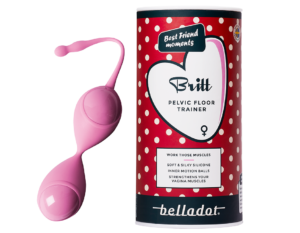Incontinence in women – train your pelvic muscles
Squeeeze! How you can prevent and cure incontinence by yourself
Incontinence can be prevented as well as cured, in several different ways. No matter what the cause is. Most people have heard of training and pelvic floor exercises. Using Kegel balls makes the training more effective. Our sexologist advises.
Although urinary incontinence affects between 10 and 25% of all women in Sweden, it’s easy to think that you’re alone with the problem. It may be because we rarely talk about it. Most types of incontinence can be prevented and cured with the help of exercise. We recommend Belladot Britt pelvic floor trainers with both beads and twine in silicone. They train and stimulate both the pelvic floor and the abdominal muscles. They may also improve your sex life. Just as the rest of the body’s muscles age, the abdominal muscles can get weaker as we grow older. Incontinence is therefore most common after menopause. Between 15 and 40% of women past menopause have problems with incontinence. In addition to age, there are several other causes of incontinence:
- Pregnancy and childbirth
- Asthma or chronic bronchitis
- Smoking
- Overweight
- Severe constipation
- Physically heavy work
There are different types of incontinence. The most common are:
Stress incontinence
Stress incontinence means that you leak a few drops of urine when you laugh, cough, sneeze, exercise, jump, lift something heavy or exert yourself in some other way.
Urge incontinence or overactive bladder
Urge incontinence means that you suddenly need to pee urgently, even if only a small amount of urine comes out. You need to pee more often than usual (more than 4–8 times a day) and at night.
Mixed incontinence
Mixed urinary incontinence is a mixture of stress and urge incontinence/overactive bladder.
Neurological bladder disorder
Neurological bladder disorder means you have a neurological disease, spinal cord injury or diabetes that makes you suddenly leak or pee yourself. You may also have trouble emptying your bladder.
Overflow Incontinence
Overflow incontinence means that the urine flows periodically or all the time. This type is more common in men who, for various reasons, are unable to completely empty the bladder.
Other types of incontinence
When the urinary bladder is irritated by urinary tract infection, you may occasionally leak. An enlarged uterus or a tumour on an ovary or the urinary bladder can cause cramps.
Preventing Incontinence – what you can do for yourself
Depending on the type of incontinence, you can prevent and even reduce your problem. Go to the toilet often – but not too often. It is important to go to the toilet regularly and not stay there too long. It is equally important not to go too often. If you have urge incontinence, one part of the therapy could be to train the bladder to hold urine for longer and longer.
Squeeze!
Pelvic floor training, also known as Kegel exercises, makes your pelvic floor muscles stronger, which has an effect on incontinence. Of women who exercise, 60–70% get better or quite well. The exercise can also improve your sex life thanks to increased blood flow, greater sensitivity, more vigour and elasticity in the vagina. This in turn may mean stronger orgasms and more enjoyment for you and your partner. Pelvic floor training is good for all kinds of incontinence and is often used to treat stress incontinence. You exercise by squeezing and lifting the pelvic floor muscles as much as possible, holding for a few seconds and relaxing for about 10 seconds. Repeat this several times over a few minutes, a couple of times a day, or a few more if you’re already having trouble. You do this for a number of months, about two to six, depending on whether you’re preventing or reducing your incontinence. By gently inserting a finger into your vagina, you can make sure you’re really squeezing. To get a better effect from the pelvic floor exercises you can use Kegel balls. They help you to squeeze correctly to get the best effect from your exercises. It is easier to lay down when using the balls for the first time. Lubricant facilitates insertion and prevents possible irritation of the vagina. We recommend Belladot Britt pelvic floor trainers with both beads and twine in silicone. They train and stimulate both the pelvic floor and the abdominal muscles.
When should I seek medical attention?
Even if you prefer to try remedying your incontinence yourself, you may require medical attention. Contact your doctor, gynaecologist or midwife for help and advice. You can also get incontinence medication. There are medicines that make the body less sensitive to signals from the bladder. Oestrogen preparations can be used to strengthen the mucosa after menopause. Electrostimulation and acupuncture sometimes work as a supplement or alternative to medication. Surgery may also be an option. Incontinence is rarely evidence of any particular disease, but can be caused by neurological diseases such as dementia, Parkinson’s disease and MS. It may also occur after a stroke. If you recognize any of the following, seek medical advice: blood visible in the urine, difficulty emptying the bladder, severe sudden urge, neurological disease such as MS or spinal cord injury. You may of course also wish to see a doctor if you want to diagnose the cause of your incontinence and get treatment for your symptoms.

